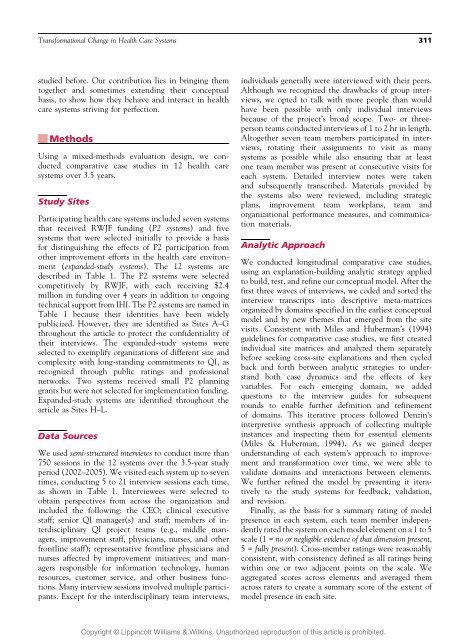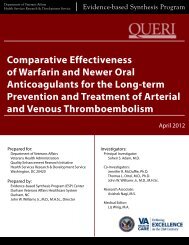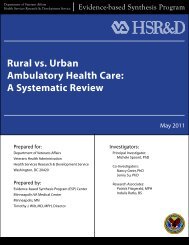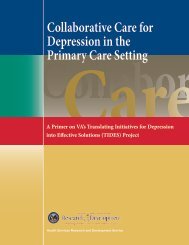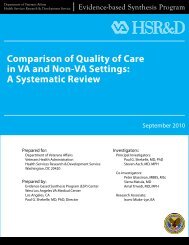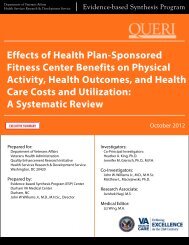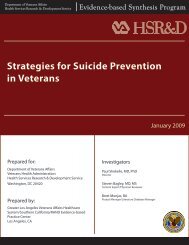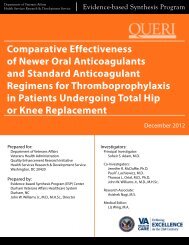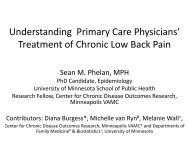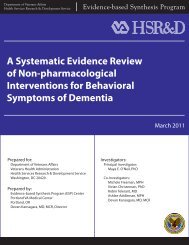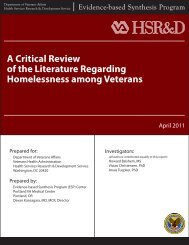VHA Systems Redesign; Transformational change in health care ...
VHA Systems Redesign; Transformational change in health care ...
VHA Systems Redesign; Transformational change in health care ...
You also want an ePaper? Increase the reach of your titles
YUMPU automatically turns print PDFs into web optimized ePapers that Google loves.
<strong>Transformational</strong> Change <strong>in</strong> Health Care <strong>Systems</strong> 311<br />
studied before. Our contribution lies <strong>in</strong> br<strong>in</strong>g<strong>in</strong>g them<br />
together and sometimes extend<strong>in</strong>g their conceptual<br />
basis, to show how they behave and <strong>in</strong>teract <strong>in</strong> <strong>health</strong><br />
<strong>care</strong> systems striv<strong>in</strong>g for perfection.<br />
Methods<br />
Us<strong>in</strong>g a mixed-methods evaluation design, we conducted<br />
comparative case studies <strong>in</strong> 12 <strong>health</strong> <strong>care</strong><br />
systems over 3.5 years.<br />
Study Sites<br />
Participat<strong>in</strong>g <strong>health</strong> <strong>care</strong> systems <strong>in</strong>cluded seven systems<br />
that received RWJF fund<strong>in</strong>g (P2 systems) and five<br />
systems that were selected <strong>in</strong>itially to provide a basis<br />
for dist<strong>in</strong>guish<strong>in</strong>g the effects of P2 participation from<br />
other improvement efforts <strong>in</strong> the <strong>health</strong> <strong>care</strong> environment<br />
(expanded-study systems). The 12 systems are<br />
described <strong>in</strong> Table 1. The P2 systems were selected<br />
competitively by RWJF, with each receiv<strong>in</strong>g $2.4<br />
million <strong>in</strong> fund<strong>in</strong>g over 4 years <strong>in</strong> addition to ongo<strong>in</strong>g<br />
technical support from IHI. The P2 systems are named <strong>in</strong><br />
Table 1 because their identities have been widely<br />
publicized. However, they are identified as Sites A–G<br />
throughout the article to protect the confidentiality of<br />
their <strong>in</strong>terviews. The expanded-study systems were<br />
selected to exemplify organizations of different size and<br />
complexity with long-stand<strong>in</strong>g commitments to QI, as<br />
recognized through public rat<strong>in</strong>gs and professional<br />
networks. Two systems received small P2 plann<strong>in</strong>g<br />
grants but were not selected for implementation fund<strong>in</strong>g.<br />
Expanded-study systems are identified throughout the<br />
article as Sites H–L.<br />
Data Sources<br />
We used semi-structured <strong>in</strong>terviews to conduct more than<br />
750 sessions <strong>in</strong> the 12 systems over the 3.5-year study<br />
period (2002–2005). We visited each system up to seven<br />
times, conduct<strong>in</strong>g 5 to 21 <strong>in</strong>terview sessions each time,<br />
as shown <strong>in</strong> Table 1. Interviewees were selected to<br />
obta<strong>in</strong> perspectives from across the organization and<br />
<strong>in</strong>cluded the follow<strong>in</strong>g: the CEO; cl<strong>in</strong>ical executive<br />
staff; senior QI manager(s) and staff; members of <strong>in</strong>terdiscipl<strong>in</strong>ary<br />
QI project teams (e.g., middle managers,<br />
improvement staff, physicians, nurses, and other<br />
frontl<strong>in</strong>e staff); representative frontl<strong>in</strong>e physicians and<br />
nurses affected by improvement <strong>in</strong>itiatives; and managers<br />
responsible for <strong>in</strong>formation technology, human<br />
resources, customer service, and other bus<strong>in</strong>ess functions.<br />
Many <strong>in</strong>terview sessions <strong>in</strong>volved multiple participants.<br />
Except for the <strong>in</strong>terdiscipl<strong>in</strong>ary team <strong>in</strong>terviews,<br />
<strong>in</strong>dividuals generally were <strong>in</strong>terviewed with their peers.<br />
Although we recognized the drawbacks of group <strong>in</strong>terviews,<br />
we opted to talk with more people than would<br />
have been possible with only <strong>in</strong>dividual <strong>in</strong>terviews<br />
because of the project’s broad scope. Two- or threeperson<br />
teams conducted <strong>in</strong>terviews of 1 to 2 hr <strong>in</strong> length.<br />
Altogether seven team members participated <strong>in</strong> <strong>in</strong>terviews,<br />
rotat<strong>in</strong>g their assignments to visit as many<br />
systems as possible while also ensur<strong>in</strong>g that at least<br />
one team member was present at consecutive visits for<br />
each system. Detailed <strong>in</strong>terview notes were taken<br />
and subsequently transcribed. Materials provided by<br />
the systems also were reviewed, <strong>in</strong>clud<strong>in</strong>g strategic<br />
plans, improvement team workplans, team and<br />
organizational performance measures, and communication<br />
materials.<br />
Analytic Approach<br />
We conducted longitud<strong>in</strong>al comparative case studies,<br />
us<strong>in</strong>g an explanation-build<strong>in</strong>g analytic strategy applied<br />
to build, test, and ref<strong>in</strong>e our conceptual model. After the<br />
first three waves of <strong>in</strong>terviews, we coded and sorted the<br />
<strong>in</strong>terview transcripts <strong>in</strong>to descriptive meta-matrices<br />
organized by doma<strong>in</strong>s specified <strong>in</strong> the earliest conceptual<br />
model and by new themes that emerged from the site<br />
visits. Consistent with Miles and Huberman’s (1994)<br />
guidel<strong>in</strong>es for comparative case studies, we first created<br />
<strong>in</strong>dividual site matrices and analyzed them separately<br />
before seek<strong>in</strong>g cross-site explanations and then cycled<br />
back and forth between analytic strategies to understand<br />
both case dynamics and the effects of key<br />
variables. For each emerg<strong>in</strong>g doma<strong>in</strong>, we added<br />
questions to the <strong>in</strong>terview guides for subsequent<br />
rounds to enable further def<strong>in</strong>ition and ref<strong>in</strong>ement<br />
of doma<strong>in</strong>s. This iterative process followed Denz<strong>in</strong>’s<br />
<strong>in</strong>terpretive synthesis approach of collect<strong>in</strong>g multiple<br />
<strong>in</strong>stances and <strong>in</strong>spect<strong>in</strong>g them for essential elements<br />
(Miles & Huberman, 1994). As we ga<strong>in</strong>ed deeper<br />
understand<strong>in</strong>g of each system’s approach to improvement<br />
and transformation over time, we were able to<br />
validate doma<strong>in</strong>s and <strong>in</strong>teractions between elements.<br />
We further ref<strong>in</strong>ed the model by present<strong>in</strong>g it iteratively<br />
to the study systems for feedback, validation,<br />
and revision.<br />
F<strong>in</strong>ally, as the basis for a summary rat<strong>in</strong>g of model<br />
presence <strong>in</strong> each system, each team member <strong>in</strong>dependently<br />
rated the system on each model element on a 1 to 5<br />
scale (1 = no or negligible evidence of that dimension present,<br />
5=fully present). Cross-member rat<strong>in</strong>gs were reasonably<br />
consistent, with consistency def<strong>in</strong>ed as all rat<strong>in</strong>gs be<strong>in</strong>g<br />
with<strong>in</strong> one or two adjacent po<strong>in</strong>ts on the scale. We<br />
aggregated scores across elements and averaged them<br />
across raters to create a summary score of the extent of<br />
model presence <strong>in</strong> each site.<br />
Copyright @ Lipp<strong>in</strong>cott Williams & Wilk<strong>in</strong>s. Unauthorized reproduction of this article is prohibited.


